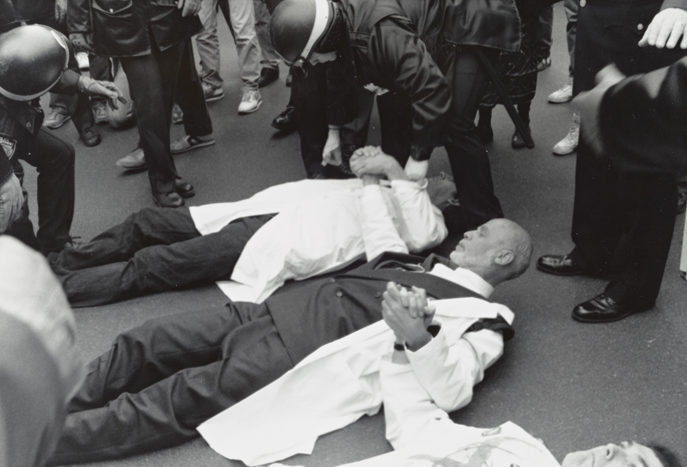The fascinating story of how AIDS activism helped usher in a "Right to Try" laws
A Freethink Update:
Shortly after we first brought you this story, the “right to try” movement achieved their biggest win yet: a federal right to try law that was passed unanimously by the U.S. senate on August 3, 2017 without a vote even taking place.
Known as unanimous consent, the new law was able to skip a vote because its sponsor, Republican Senator Ron Johnson (WI), threatened to hold up an FDA reauthorization bill if it did not include a right to try amendment. While he went on to lose that battle, an agreement was reached to allow a new bill to pass unopposed, which was eventually signed by President Trump on May 30, 2018.
Called the Trickett Wendler, Frank Mongiello, Jordan McLinn and Matthew Bellina Right to Try Act, the new bill allows terminally ill patients that have been diagnosed with a life-threatening disease or condition access to unapproved medical treatments and products before they’re cleared for use by the FDA.
Since almost 40 states had a right to try law on the books at the time, the federal bill’s passing wasn’t exactly unexpected—but critics say that the national law doesn’t go far enough.
While the law allows patients to petition drug manufacturers outside of an official clinical trial, there is no mandate for doctors to prescribe the drugs, insurance companies to pay for them, and manufacturers to provide the drugs to patients. Some even charge that this may lead to a breakdown of our clinical trials system as patients opt out of heavily regulated trials, instead preferring to get direct access to investigational drugs through the right to try bill’s petition method.
Others say that because the experimental therapies have not completed clinical testing, the safety and efficacy of any new treatments is unknown and may cause increased suffering and possibly even hasten death. They point to the FDA’s existing expanded access program that already provides access to experimental therapies to in-need patients.
But tell that to Dr. Ebrahim Delpassand, a Houston oncologist who says that he successfully treated almost 80 patients for neuroendocrine cancer with the 177Lu-DOTATATE drug under a Texas right to try law after the FDA tried to limit the number of patients in his ongoing clinical trial.
Other proponents of the federal right to try law say that the bill increases transparency on the efficacy of investigational drugs because drug manufacturers are now required to submit annual summaries of drugs used under the law. Critics, however, say that this is a new reason for drug manufacturers to deny requests that may open them up to increased regulation or lawsuits from family members after an experimental treatment gone bad.
But that’s not stopping the right to try movement, who are still working at the state level to pass laws that increases patient access to experimental medical treatments such as stem cell and tissue based regenerative therapies such as with Texas’ HB 805 and North Carolina’s HB 934.
—
What is Right to Try?
Since 2014, 31 states have passed legislation that would allow patients suffering from terminal illnesses to try medical treatments that haven’t been approved by the Food and Drug Administration. They’re called “right to try” laws, and the American medical community is in a heated debate with advocates over whether these laws and the practices they promote are good for patients, or even an effective means of getting experimental drugs into the hands of people who can’t benefit from treatments already on the market. Considering how many potentially ground-breaking treatments are still in the trial phase, the question of who can use what drugs and when will only get more attention as supporters of right-to-try laws continue to court and persuade state lawmakers.
And as the debate heats up, it’s worth revisiting the period of unrest that first drove the right to try movement to the forefront of America’s policy debate.
How AIDS Activists Affected “Right to Try” Laws
In the late 1980s…there was a single drug approved by the Food and Drug Administration permitted to help prolong the lives of people with AIDS.
In the late 1980s, Americans were dying by the thousands from the opportunistic infections that came from full-blown AIDS. There was a single drug approved by the Food and Drug Administration permitted to help prolong the lives of people with AIDS. This first drug, azidothymidine—or AZT—was approved for use in AIDS patients in what was a remarkably fast process for the FDA at the time: 25 months.
But AZT had some very serious side effects that caused other health threats, and not all AIDS patients could endure the treatment. The lack of “officially” approved treatment options gave rise to a large black market to provide access to non-permitted and foreign medicines in order to bypass the FDA.
This black market was most famously highlighted in the 2013 Academy Award-winning film “Dallas Buyers Club,” based on real-life drug smuggler (and AIDS patient) Ron Woodroof. Woodroof was not unique. There were groups of people across the country working to bring drugs into the United States from Mexico, Europe, and elsewhere, regardless of the FDA’s approval process.

AIDS activists didn’t want to settle for such an environment. The AIDS Coalition to Unleash Power (ACT UP) formed in 1987 and became the largest and most significant activist group publicly fighting for the government and populace to address the growing crisis. Many Americans may remember their marches, protests, social activism, “die-ins,” and their “Silence = Death” slogan.
Their activism ran much deeper than calling for more spending on AIDS research and better access to health care. They were heavily involved in the push to convince the FDA and the National Institutes of Health (NIH) to not just approve drugs more quickly, but to reform their entire process of how the bureaucratic agencies and scientific communities were approaching the AIDS crisis.
The efforts were the focus of the 2012 documentary “How to Survive a Plague.” Their protests at FDA and NIH facilities featured chants like “AZT is not enough—give us all the other stuff!” At the same time, ACT UP had a “Treatment and Data Committee” that wasn’t about creating public spectacles but rather researching and keeping up with the latest information on research and taking ownership of treatment. They became experts in their condition until they were as familiar with the science involved as the researchers themselves.
Because of their commitment, as activists they were able to propose specific solutions, not just make demands. They were able to point out specific drugs that were approved for use in other countries that remained out of reach in the United States. Activist Peter Staley appeared on Crossfire to point out a drug he would find useful for his treatment that had been available over the counter in Japan for years. Also of note: On the show, host “on the left” Thomas Braden worried that loosening regulations to permit drugs would lead to “quack” medicines that could cause more harm, while the more conservative Patrick Buchanan defended the right of people with AIDS to take whatever drugs they felt might prolong their lives.
After some early activism of ACT UP, the FDA approved the use of a drug that helped fight blindness in some people with AIDS.
After some early activism of ACT UP, the FDA approved the use of a drug that helped fight blindness in some people with AIDS. But they didn’t stop with singular pushes for individual medicines. The activists developed a “National AIDS Treatment Research Agenda” in 1989 and introduced it to researchers and government officials. This agenda featured nuts-and-bolts technical recommendations on how and where to focus medical research to develop specific AIDS treatments.
It’s important to note that the success of their efforts didn’t always result in the best solutions. By the early 1990s it became clear to researchers that medicines that activists themselves had pushed were much less effective than previously believed. There were struggles within the activist community in how to approach next steps. The Treatment and Data Committee broke off from ACT UP and became the Treatment Action Group (TAG).
But neither the scientists nor the activists gave up, and now in 2016, HIV is a manageable illness with access to the right medicines. The lesson wasn’t really that people with life-threatening illness wanted to just down any drugs they could get their hands on and wanted the FDA to just rubber stamp everything. What these initial “right to try” activists accomplished is getting regulators and the medical community to treat patients as stakeholders in the drug approval process. ACT UP and TAG’s insistence in self-education and self-determination helped create a framework where citizens with serious illnesses weren’t just passive recipients of whatever remedies the government was willing to provide to them.
For more interesting news about people who changed the way we think about medicine, check out our story on Dr. Dritz and keep it right here on Freethink. We’re Freethink Media, and we move the world, one story at a time.




